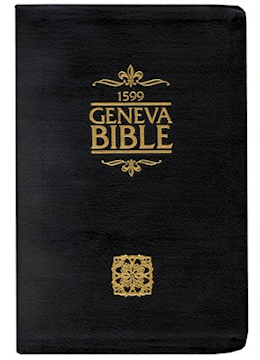Textus Receptus Bibles
Geneva Bible 1560/1599
| 5:1 | Then the Philistims tooke the Arke of God and caried it from Eben-ezer vnto Ashdod, |
| 5:2 | Euen the Philistims tooke ye Arke of God, and brought it into the house of Dagon, and set it by Dagon. |
| 5:3 | And when they of Ashdod rose the next day in the morning, beholde, Dagon was fallen vpon his face on the ground before the Arke of the Lord, and they tooke vp Dagon, and set him in his place againe. |
| 5:4 | Also they rose vp earely in the morning the next day, and beholde, Dagon was fallen vpon his face on the ground before the Arke of the Lord, and the head of Dagon and the two palmes of his hands were cut off vpon the thresholde: onely the stumpe of Dagon was left to him. |
| 5:5 | Therefore the Priests of Dagon, and all that come into Dagons house tread not on the thresholde of Dagon in Ashdod, vnto this day. |
| 5:6 | But the hand of the Lord was heauie vpon them of Ashdod, and destroyed them, and smote them with the emerods, both Ashdod, and the coastes thereof. |
| 5:7 | And when the men of Ashdod sawe this, they sayd, Let not the Arke of the God of Israel abide with vs: for his hand is sore vpon vs and vpon Dagon our god. |
| 5:8 | They sent therefore and gathered all the princes of the Philistims vnto them, and sayde, What shall we doe with the Arke of the God of Israel? And they answered, Let the Arke of the God of Israel be caried about vnto Gath: and they caried the Arke of the God of Israel about. |
| 5:9 | And when they had caried it about, the hand of the Lord was against the citie with a very great destruction, and he smote the men of the citie both small and great, and they had emerods in their secret partes. |
| 5:10 | Therefore they sent the Arke of God to Ekron: and assoone as the Arke of God came to Ekron, the Ekronites cryed out, saying, They haue brought the Arke of the God of Israel to vs to slay vs and our people. |
| 5:11 | Therefore they sent, and gathered together all the princes of the Philistims and sayd, Sende away the Arke of the God of Israel, and let it returne to his owne place, that it slay vs not and our people: for there was a destruction and death throughout all the citie, and the hand of God was very sore there. |
| 5:12 | And the men that dyed not, were smitten with the emerods: and the cry of the citie went vp to heauen. |

Geneva Bible 1560/1599
The Geneva Bible is one of the most influential and historically significant translations of the Bible into English, preceding the King James translation by 51 years. It was the primary Bible of 16th century Protestantism and was the Bible used by William Shakespeare, Oliver Cromwell, John Knox, John Donne, and John Bunyan. The language of the Geneva Bible was more forceful and vigorous and because of this, most readers strongly preferred this version at the time.
The Geneva Bible was produced by a group of English scholars who, fleeing from the reign of Queen Mary, had found refuge in Switzerland. During the reign of Queen Mary, no Bibles were printed in England, the English Bible was no longer used in churches and English Bibles already in churches were removed and burned. Mary was determined to return Britain to Roman Catholicism.
The first English Protestant to die during Mary's turbulent reign was John Rogers in 1555, who had been the editor of the Matthews Bible. At this time, hundreds of Protestants left England and headed for Geneva, a city which under the leadership of Calvin, had become the intellectual and spiritual capital of European Protestants.
One of these exiles was William Whittingham, a fellow of Christ Church at Oxford University, who had been a diplomat, a courtier, was much traveled and skilled in many languages including Greek and Hebrew. He eventually succeeded John Knox as the minister of the English congregation in Geneva. Whittingham went on to publish the 1560 Geneva Bible.
This version is significant because, it came with a variety of scriptural study guides and aids, which included verse citations that allow the reader to cross-reference one verse with numerous relevant verses in the rest of the Bible, introductions to each book of the Bible that acted to summarize all of the material that each book would cover, maps, tables, woodcut illustrations, indices, as well as other included features, all of which would eventually lead to the reputation of the Geneva Bible as history's very first study Bible.